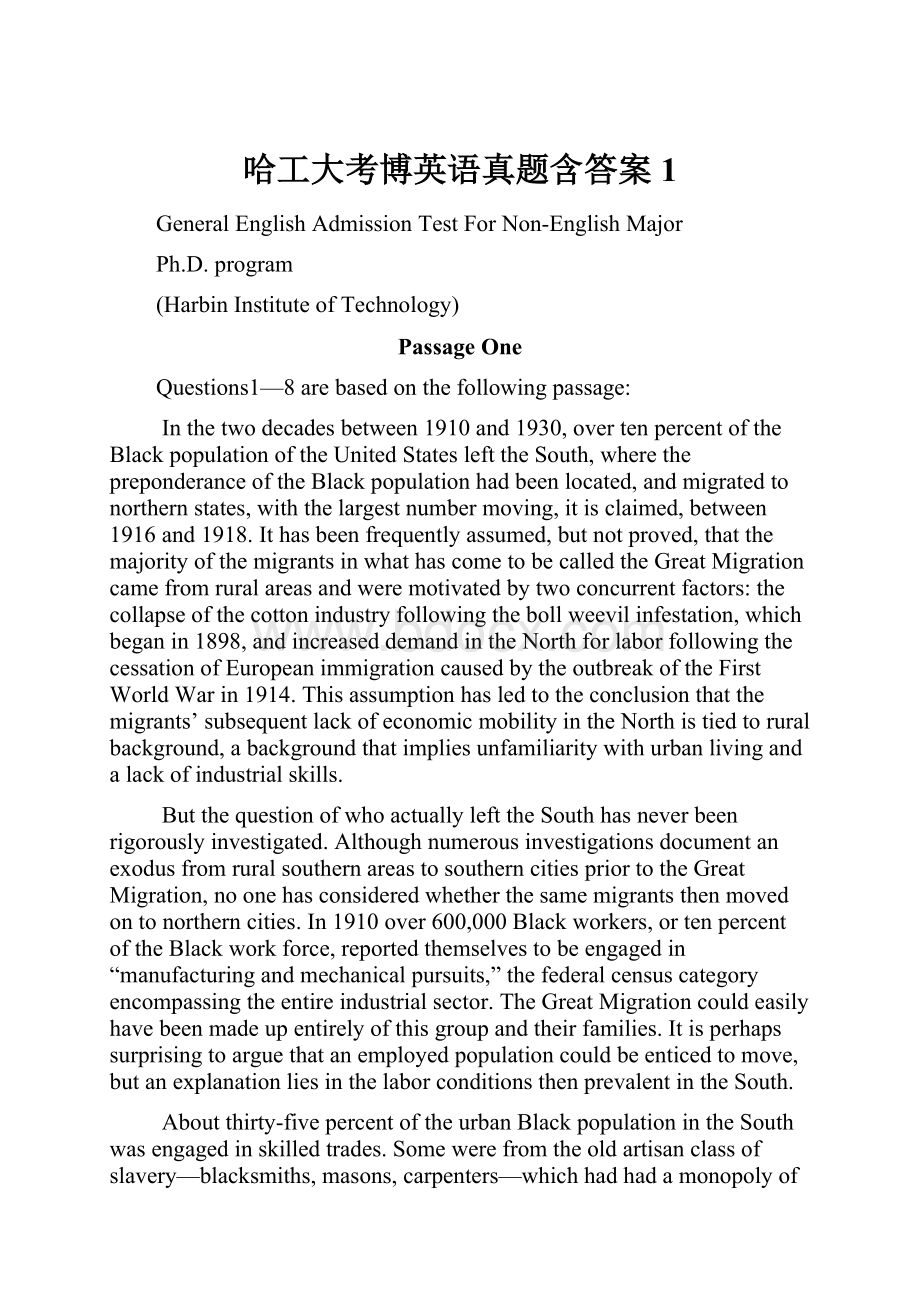哈工大考博英语真题含答案1.docx
《哈工大考博英语真题含答案1.docx》由会员分享,可在线阅读,更多相关《哈工大考博英语真题含答案1.docx(22页珍藏版)》请在冰豆网上搜索。

哈工大考博英语真题含答案1
GeneralEnglishAdmissionTestForNon-EnglishMajor
Ph.D.program
(HarbinInstituteofTechnology)
PassageOne
Questions1—8arebasedonthefollowingpassage:
Inthetwodecadesbetween1910and1930,overtenpercentoftheBlackpopulationoftheUnitedStateslefttheSouth,wherethepreponderanceoftheBlackpopulationhadbeenlocated,andmigratedtonorthernstates,withthelargestnumbermoving,itisclaimed,between1916and1918.Ithasbeenfrequentlyassumed,butnotproved,thatthemajorityofthemigrantsinwhathascometobecalledtheGreatMigrationcamefromruralareasandweremotivatedbytwoconcurrentfactors:
thecollapseofthecottonindustryfollowingthebollweevilinfestation,whichbeganin1898,andincreaseddemandintheNorthforlaborfollowingthecessationofEuropeanimmigrationcausedbytheoutbreakoftheFirstWorldWarin1914.Thisassumptionhasledtotheconclusionthatthemigrants’subsequentlackofeconomicmobilityintheNorthistiedtoruralbackground,abackgroundthatimpliesunfamiliaritywithurbanlivingandalackofindustrialskills.
ButthequestionofwhoactuallylefttheSouthhasneverbeenrigorouslyinvestigated.AlthoughnumerousinvestigationsdocumentanexodusfromruralsouthernareastosoutherncitiespriortotheGreatMigration,noonehasconsideredwhetherthesamemigrantsthenmovedontonortherncities.In1910over600,000Blackworkers,ortenpercentoftheBlackworkforce,reportedthemselvestobeengagedin“manufacturingandmechanicalpursuits,”thefederalcensuscategoryencompassingtheentireindustrialsector.TheGreatMigrationcouldeasilyhavebeenmadeupentirelyofthisgroupandtheirfamilies.Itisperhapssurprisingtoarguethatanemployedpopulationcouldbeenticedtomove,butanexplanationliesinthelaborconditionsthenprevalentintheSouth.
Aboutthirty-fivepercentoftheurbanBlackpopulationintheSouthwasengagedinskilledtrades.Somewerefromtheoldartisanclassofslavery—blacksmiths,masons,carpenters—whichhadhadamonopolyofcertaintrades,buttheyweregraduallybeingpushedoutbycompetition,mechanization,andobsolescence.Theremainingsixty-fivepercent,morerecentlyurbanized,workedinnewlydevelopedindustries—tobacco,lumber,coalandironmanufacture,andrailroads.WagesintheSouth,however,werelow,andBlackworkerswereaware,throughlaborrecruitersandtheBlackpress,thattheycouldearnmoreevenasunskilledworkersintheNorththantheycouldasartisansintheSouth.Afterthebollweevilinfestation,urbanBlackworkersfacedcompetitionfromthecontinuinginfluxofbothBlackandWhiteruralworkers,whoweredriventoundercutthewagesformerlypaidforindustrialfobs.Thus,amovenorthwouldbeseenasadvantageoustoagroupthatwasalreadyurbanizedandsteadilyemployed,andtheeasyconclusiontyingtheirsubsequenteconomicproblemsintheNorthtotheirruralbackgroundcomesintoquestion.
1.Theauthorindicatesexplicitlythatwhichofthefollowingrecordshasbeenasourceofinformationinherinvestigation?
(A)UnitedStatesImmigrationServicereportsfrom1914to1930.
(B)Payrollsofsouthernmanufacturingfirmsbetween1910and1930.
(C)Thevolumeofcottonexportsbetween1898and1910.
(D)Thefederalcensusof1910.
2.Inthepassage,theauthoranticipateswhichofthefollowingasapossibleobjectiontoherargument?
ItisuncertainhowmanypeopleactuallymigratedduringtheGreatMigration.
TheeventualeconomicstatusoftheGreatMigrationmigrantshasnotbeenadequatelytraced.
Itisnotlikelythatpeoplewithsteadjobswouldhavereasontomovetoanotherareaofthecountry.
Itisnottruethattheterm“manufacturingandmechanicalpursuits”actuallyencompassestheentireindustrialsector.
3.Accordingtothepassage,whichofthefollowingistrueofwagesinsoutherncitiesin1910?
(A)Theywerebeingpushedlowerasaresultofincreasedcompetition.
(B)Theyhadbeguntorisesothatsouthernindustrycouldattractruralworkers.
(C)Theyhadincreasedforskilledworkersbutdecreasedforunskilledworkers.
(D)Theyhadincreasedinlargesoutherncitiesbutdecreasedinsmallsoutherncities.
4.TheauthorciteseachofthefollowingaspossibleinfluencesinaBlackworker’sdecisiontomigratenorthintheGreatMigrationEXCEPT_________.
(A)wagelevelsinnortherncities
(B)laborrecruiters
(C)competitionfromruralworkers
(D)votingrightsinnorthernstates
5.Itcanbeinferredfromthepassagethatthe“easyconclusion”mentionedinline16ofthelastparagraphisbasedonwhichofthefollowingassumptions?
(A)Peoplewhomigratefromruralareastolargecitiesusuallydosoforeconomicreasons.
(B)Mostpeoplewholeaveruralareastotakejobsincitiesreturntoruralareasassoonasitis
financiallypossibleforthemtodoso.
(C)Peoplewithruralbackgroundsarelesslikelytosucceedeconomicallyincitiesthanarethose
withurbanbackgrounds.
(D)Mostpeoplewhowereonceskilledworkersarenotwillingtoworkasunskilledworkers.
6.Theprimarypurposeofthepassageisto________.
Supportanalternativetoanacceptedmethodology
Presentevidencethatresolvesacontradiction
Introducearecentlydiscoveredsourceofinformation
Challengeawidelyacceptedexplanation
7.Accordingtoinformationinthepassage,whichofthefollowingisacorrectsequenceofgroupsofworkers,fromhighestpaidtolowestpaid,intheperiodbetween1910and1930?
ArtisansintheNorth;artisansintheSough;unskilledworkersintheNorth;unskilledworkersinthesouth.
ArtisansintheNorthandSouth;unskilledworkersintheNorth;unskilledworkersintheSouth.
ArtisansintheNorth;unskilledworkersintheNorth;artisansintheSouth.
ArtisansintheNorthandSouth;unskilledurbanworkersintheNorth;unskilledruralworkersintheSouth.
8.Thematerialinthepassagewouldbemostrelevanttoalongdiscussionofwhichofthefollowingtopics?
ThereasonsforthesubsequenteconomicdifficultiesofthosewhoparticipatedintheGreatMigration.
TheeffectofmigrationontheregionaleconomiesoftheUnitedStatesfollowingtheFirstWorldWar.
ThetransitionfromaruraltoanurbanexistenceforthosewhomigratedintheGreatMigration.
ThetransformationoftheagriculturalSouthfollowingthebollweevilinfestation.
PassageTwo
Question9—17arebasedonthefollowingpassage:
Priorto1975,unioneffortstoorganizepublic-sectorclericalworker,mostofwhomarewomen,weresomewhatlimited.Thefactorsfavoringunionizationdrivesseemtohavebeeneitherthepresenceoflargenumbersofworkers,asinNewYorkCity,tomakeitworththeeffort,ortheconcentrationofsmallnumbersinoneortwolocations,suchasahospital,tomakeitrelativelyeasy.Receptivitytounionizationontheworkers,partwasalsoaconsideration,butwhentherewerelargenumbersinvolvedortheclericalworkersweretheonlyunorganizedgroupinajurisdiction,themultioccupationalunionswouldoftentrytoorganizethemregardlessoftheworkers’initialreceptivity.Thestrategicreasoningwasbased,first,ontheconcernthatpoliticiansandadministratorsmightplayoffunionizedagainstnonunionizedworkers,and,second,ontheconvictionthatafullyunionizedpublicworkforcemeantpower,bothatthebargainingtableandinthelegislature.Inlocalitieswhereclericalworkerswerefewinnumber,werescatteredinseveralworkplaces,andexpressednointerestinbeingorganized,unionsmoreoftenthannotignoredtheminthepre-1975period.
Butsincethemid-1970’s,adifferentstrategyhasemerged.In1977,34percentofgovernmentclericalworkerswererepresentedbyalabororganization,comparedwith46percentofgovernmentprofessionals,44percentofgovernmentblue-collarworkers,and41percentofgovernmentserviceworkers.Sincethen,however,thebiggestincreasesinpublic-sectorunionizationhavebeenamongclericalworkers.Between1977and1980,thenumberofunionizedgovernmentworkersinblue-collarandserviceoccupationsincreasedonlyabout1.5percent,whileinthewhite-collaroccupationstheincreasewas20percentandamongclericalworkersinparticular,theincreasewas22percent.
Whataccountsforthisupsurgeinunionizationamongclericalworkers?
First,morewomenhaveenteredtheworkforceinthepastfewyears,andmoreofthemplantoremainworkinguntilretirementage.Consequently,theyareprobablymoreconcernedthantheirpredecessorswereaboutjobsecurityandeconomicbenefits.Also,thewomen’smovementhassucceededinlegitimizingtheeconomicandpoliticalactivismofwomenoftheirownbehalf,therebyproducingamorepositiveattitudetowardunions.Theabsenceofanycomparableincreaseinunionizationamongprivate-sectorclericalworker,however,identifiestheprimarycatalyst—thestructuralchangeinthemultioccupationalpublic-sectorunionsthemselves.Overthepasttwentyyears,theoccupationaldistributionintheseunionshasbeensteadilyshiftingfrompredominantlyblue-collartopredominantlywhite-collar.Becausetherearefarmorewomeninwhite-collarjobs,anincreaseintheproportionoffemalemembershasaccompaniedtheoccupationalshiftandhasalteredunionpolicy-makinginfavoroforganizingwomenandaddressingwomen’sissues.
9.Accordingtothepassage,thepublic-sectorworkerswhoweremostlikelytobelongtounionsin1977were______.
(A)professionals
(B)managers
(C)clericalworkers
(D)serviceworkers
10.Theauthorcitesunioneffortstoachieveafullyunionizedworkforce(line11—15)inordertoaccountforwhy______.
(A)politiciansmighttrytoopposepublic-sectorunionorganizing
(B)public-